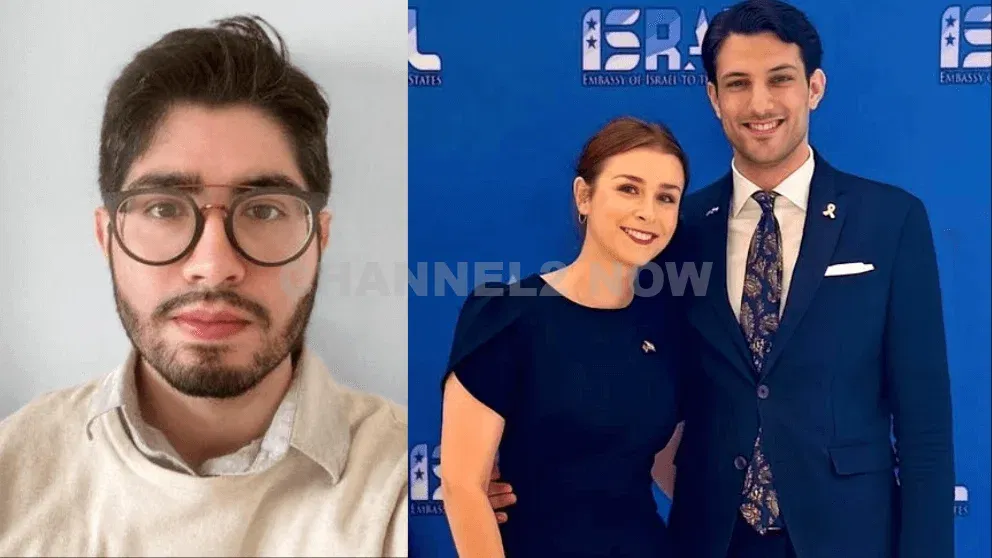In an act that has reverberated across international and diplomatic circles, the brutal murder of Yaron Lischinsky, 28, and Sarah Milgrim, both staff members at the Israeli Embassy in Washington, D.C., has ignited intense grief, outrage, and renewed fears of antisemitic terrorism in the United States. The shooting occurred Wednesday night outside the Capital Jewish Museum during a prestigious “Young Diplomats Reception” hosted by the American Jewish Committee. The suspected gunman, identified as Elias Rodriguez, 30, of Chicago, approached a small group and opened fire at close range, striking both victims. His alleged cries of “Free, Free Palestine!” as he was detained have further inflamed the situation, suggesting a targeted, ideological act of violence.
The victims, Lischinsky and Milgrim, were not only emerging figures in diplomatic service, but also a couple on the cusp of a major life milestone. According to statements from Israeli Ambassador Yechiel Leiter and embassy spokesperson Tal Naim Cohen, Lischinsky had just purchased an engagement ring and was planning to propose to Milgrim during an upcoming trip to Jerusalem. Their lives, emblematic of commitment to diplomacy, faith, and regional cooperation, were cut short in a moment that now serves as both personal tragedy and political flashpoint.
The attack has been labeled a potential act of antisemitic terrorism and is under active investigation by the FBI’s Joint Terrorism Task Force in coordination with the Metropolitan Police Department. U.S. Secretary of Homeland Security Kristi Noem swiftly confirmed the deaths, condemning the killings as “senseless” and “deeply troubling.” The speed with which federal authorities mobilized reflects the severity with which the incident is being treated, both as a breach of diplomatic safety and as a hate-motivated crime targeting Jewish and Israeli individuals on American soil.
Yaron Lischinsky, serving as a political officer at the Israeli Embassy, held an impressive academic background, including a master’s degree in Government, Diplomacy & Strategy from Reichman University and a bachelor’s degree in International Relations from Hebrew University. Lischinsky was known not merely as a functionary of statecraft, but as a visionary advocate of interfaith dialogue and a promoter of the Abraham Accords — a hallmark of recent efforts to normalize relations between Israel and several Arab nations. His belief in peaceful regional cooperation and religious co-existence formed a cornerstone of his diplomatic identity. According to public records on his professional page, he proudly identified as “an ardent believer in the vision outlined in the Abraham Accords,” which seek to recalibrate the Middle East toward mutual recognition and enduring peace.
Milgrim, also a member of the Israeli Embassy staff, had made similar strides in her career, although fewer biographical details were made available at the time of publication. What is known is that she and Lischinsky were seen as rising stars among the younger generation of Israeli diplomatic personnel — thoughtful, passionate, and dedicated to fostering understanding in increasingly polarized times.
The attack took place just as the “Young Diplomats Reception” — designed as a non-partisan, community-building event — was getting underway. These receptions are typically organized to foster intercultural exchange, establish professional networks, and strengthen relationships between embassy personnel and local Jewish American communities. Hosted by the American Jewish Committee (AJC), the event was being held at the Capital Jewish Museum, a symbolic and strategically chosen location meant to honor Jewish history, culture, and resilience. According to AJC CEO Ted Deutch, the reception was intended to celebrate “shared values, identity, and diplomacy.” The horror that unfolded instead has darkened the spirit of that intention and raised serious questions about the vulnerability of Jewish institutions and diplomatic personnel, even within one of the most heavily policed cities in the world.
Eyewitness accounts indicate that Elias Rodriguez had been loitering outside the museum for some time before the shooting occurred. Metropolitan Police Chief Pamela Smith described how Rodriguez began pacing before suddenly approaching a group and firing without warning. Both victims were shot at close range, suggesting intent, planning, and a chilling level of composure. Rodriguez then entered the museum itself, where he was subdued by on-site security. While detained, he reportedly shouted political slogans supportive of Palestine and directed officers to where he had discarded the weapon.
Though no additional suspects are currently being sought, law enforcement has left little ambiguity regarding the ideological dimensions of the attack. The suspect’s shouted slogans and choice of targets during a Jewish community event suggest premeditation grounded in political or religious animus. In recent years, there has been growing concern over the intersection of anti-Zionist rhetoric and outright antisemitism, a dynamic that law enforcement, civil rights advocates, and Jewish organizations have all grappled with as tensions in the Middle East echo throughout the diaspora.
Statements from high-ranking officials poured in within hours. Former U.S. President Donald Trump described the killings as “obviously based on antisemitism” and called for unity against “hatred and radicalism,” asserting that such ideologies “have no place in the USA.” Israeli President Isaac Herzog echoed this sentiment, calling the murders “a despicable act of hatred and antisemitism,” and vowing continued cooperation between the U.S. and Israel in combatting terror. These reactions, swift and unequivocal, underscore the broader geopolitical implications of what some are now calling an act of domestic terrorism with international reverberations.
Attorney General Pam Bondi and Acting U.S. Attorney for D.C. Jeanine Pirro were both seen at the crime scene shortly after the attack. According to reports, Bondi remained in constant communication with former President Trump throughout the evening, suggesting both the gravity of the incident and its resonance within conservative political circles. Given Bondi’s background in state-level prosecution and her role in previous national investigations, her immediate presence signals the potential federal weight being brought to bear on the ongoing inquiry.
The tragic killing of Lischinsky and Milgrim also raises questions about the security protocols in place for foreign embassy staff. Embassies, particularly those representing nations involved in sensitive geopolitical disputes, are accustomed to heightened security. Yet the targeting of these individuals outside the confines of their diplomatic compound — at a cultural venue during a public event — illustrates the limitations of traditional security perimeters. The event was intended as a gesture of outreach and openness, yet its openness became a vulnerability.
More broadly, this attack has reignited long-standing concerns within the Jewish community in the U.S. about rising antisemitic incidents. According to data from the Anti-Defamation League (ADL), recent years have seen a marked increase in antisemitic attacks and threats across the country. Synagogues, community centers, and cultural institutions have found themselves increasingly in need of private security, even in urban centers like Washington, D.C., where one might assume a baseline of safety.
Lischinsky’s religious background — known and respected within Israel’s Messianic Jewish community — further adds to the layered symbolism of the tragedy. His father, a member of a Messianic congregation in Jerusalem, is part of a growing movement within Israel that seeks to reconcile Jewish identity with belief in Jesus as the Messiah. This theological stance, while controversial in some circles, often serves as a bridge to dialogue with Christian communities, another testament to Lischinsky’s commitment to interfaith cooperation.
The Israeli Embassy, in coordination with the U.S. State Department, is now leading efforts to support the bereaved families and affected personnel. Funeral arrangements for Lischinsky are being handled in conjunction with Israeli authorities, with plans to return his body to Jerusalem for burial. Milgrim’s family, also devastated by the loss, has requested privacy during what spokespersons have called “an unimaginably painful time.”
The Capital Jewish Museum, now both a site of remembrance and trauma, has temporarily closed to the public. In a statement issued early Thursday morning, museum administrators pledged to reopen with enhanced security measures and renewed resolve. “This museum exists to celebrate Jewish life, resilience, and identity,” the statement read. “We will not let violence silence our mission.”
For the American Jewish Committee, the organization responsible for hosting the reception, the attack represents an unprecedented violation of a carefully cultivated tradition of diplomacy and cross-cultural celebration. CEO Ted Deutch’s remarks emphasized both heartbreak and defiance: “We are devastated that an unspeakable act of violence took place outside the venue,” he said. “Our hearts are with those who were harmed and their families.”
As investigators comb through Elias Rodriguez’s background, social media history, and potential affiliations, the broader community is left grappling with more than grief. The attack on Lischinsky and Milgrim has become a moment of national and international reckoning — a stark reminder that ideological extremism can manifest even amid the most innocuous settings. And as Jewish communities from Jerusalem to Washington mourn, there is a shared understanding that what occurred on that fateful Wednesday night was not just an act of murder, but an attempt to strike fear into a community whose legacy is defined by resilience.
In the days ahead, the attention of law enforcement, media, and diplomatic officials will remain focused on understanding how this attack was planned, how such a breach was possible, and what steps can be taken to ensure it never happens again. For the friends, family, and colleagues of Yaron Lischinsky and Sarah Milgrim, however, the questions will be far more personal. What might have been — the engagement in Jerusalem, the unfolding careers in diplomacy, the possibility of a shared future — now lives only in memory.
This tragedy, embedded in the volatile crossroads of ideology, identity, and public life, has already become a defining moment in the current landscape of antisemitic violence in America. As investigations continue, and as new facts emerge, the deaths of Lischinsky and Milgrim will remain a haunting testament to the risks borne by those who work in diplomacy, who stand for peace, and who gather to celebrate community even in uncertain times.


Leave a Reply